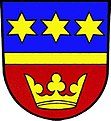Dobroslavice
| Dobroslavice | ||||
|---|---|---|---|---|
|
||||
| Basic data | ||||
| State : |
|
|||
| Region : | Moravskoslezský kraj | |||
| District : | Opava | |||
| Area : | 723 ha | |||
| Geographic location : | 49 ° 53 ' N , 18 ° 9' E | |||
| Height: | 308 m nm | |||
| Residents : | 756 (Jan. 1, 2019) | |||
| Postal code : | 747 94 | |||
| structure | ||||
| Status: | local community | |||
| Districts: | 1 | |||
| administration | ||||
| Mayor : | Jiří Konštacký (as of 2009) | |||
| Address: | Dobroslavice, Slezská 36 747 92 Háj ve Slezsku |
|||
| Municipality number: | 569895 | |||
| Website : | www.obec-dobroslavice.cz | |||
Dobroslavice (German Dobroslawitz ) is a municipality in the Okres Opava in the Moravian-Silesian region in the Czech Republic .
geography
Dobroslavice is located five kilometers southwest of Hlučín . Neighboring towns are Jilešovice in the north, Děhilov and Bobrovniky in the southeast, Plesná in the south, Velká Polom in the southwest and Háj ve Slezsku in the northwest. Road 469 to Hlučín runs to the east.
history
Dobroslawitz was first mentioned in 1377 when the Duchy of Opava was divided when it belonged to the rule of Hrabin of Heinrich von Bítov ( Jindřich z Bětova also z Bítova ). From 1424 until the beginning of the 16th century it was owned by the Knights of Czochendorf, who built a fort, which was first mentioned in 1517. In the second half of the 16th century Dobroslawitz belonged to the Lords of Würben . In 1577 Albrecht von Würben had the fort converted into a Renaissance palace. The following owners included the Baron Johann Georg Czigan , the Tvorkovský , the Sedlnitzky von Choltitz , the Würben von Freudenthal ( Bruntálští z Vrbna ) and, in the 18th century, the Italian Count Giannini. At the beginning of the 18th century, the castle was rebuilt in the Baroque style and a French park was created at the beginning of the 19th century.
After the abolition of patrimonial Dobroslawitz belonged to the district administration Troppau from 1850, which came to the newly founded Czechoslovakia in 1918 . From 1860 the manor and the castle belonged to Count Wilczek, who were expropriated in 1945. After the Munich Agreement in 1938, the place was added to the German Reich and belonged to the Wagstadt district until 1945 . During the Moravian Ostrava operation in the spring of 1945, around 80% of the buildings were destroyed and parts of the castle burned down. After the Second World War, Dobroslavice came back to Czechoslovakia in 1945. The place was subsequently rebuilt. The castle was devastated and parts of the castle park parceled out as building land. In 1976 Dobroslavice was incorporated into Hlučín. Since 1992 it has been an independent municipality again.
Community structure
No districts are shown for the municipality of Dobroslavice.
Attractions
- Castle park with castle chapel
- Marian column from the 19th century
- Dobroslavice Castle was built on the site of a castle in the second half of the 16th century and rebuilt in the Baroque style at the beginning of the 18th century. During the Second World War it was partially destroyed and not rebuilt.
literature
- Joachim Bahlcke , Winfried Eberhard, Miloslav Polívka (eds.): Handbook of historical places . Volume: Bohemia and Moravia (= Kröner's pocket edition . Volume 329). Kröner, Stuttgart 1998, ISBN 3-520-32901-8 , pp. 112-113.


